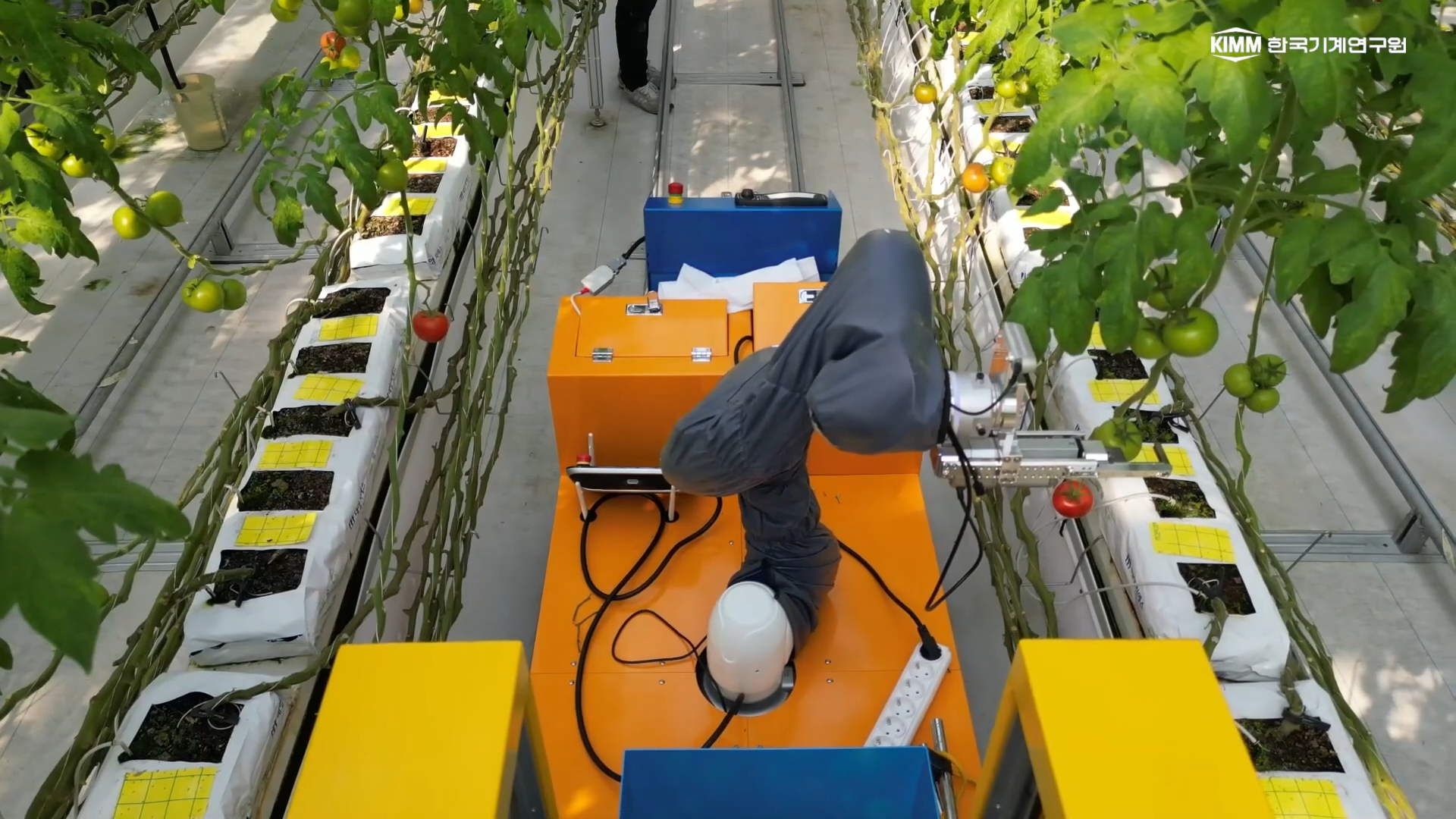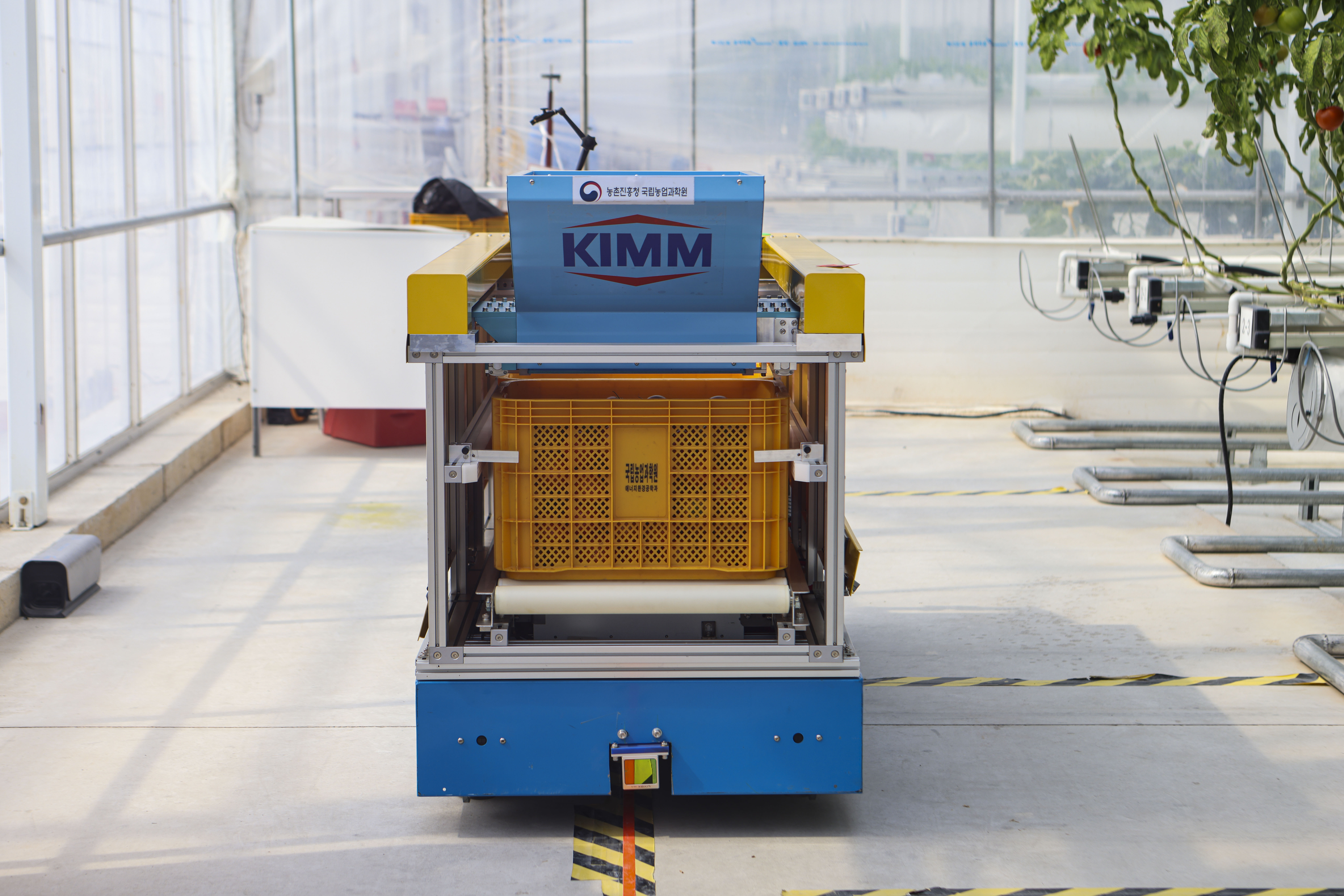
- Created2023.03.16
Completion of a System of Robots that Use Teamwork to Pick Fruit and Transport Them All on Their Own!
- KIMM develops ‘a multiple-robot system for harvesting crops’ -
- Development of fully automated harvesting and transportation robots using cutting-edge mechanical, AI, and autonomous driving technologies -
A system of robots that harvest and transport crops on their own without human assistance has been developed for use in agricultural facilities such as smart farms.
The research team under Choi Tae-yong, principal researcher at the AI Robot Research Division’s Department of Robotics and Mechatronics of the Korea Institute of Machinery and Materials (President Park Sang-jin, hereinafter referred to as KIMM), an institution under the jurisdiction of the Ministry of Science and ICT, has developed a multiple-robot system for harvesting crops. This technology can be used to help at agricultural sites where there is a noticeable shortage of manpower by harvesting crops through an automated system. This system also includes robots that use autonomous driving technology to then transport the harvested crops to loading docks.

KIMM’s new multiple-robot system for harvesting horticultural crops consists of harvesting robots and transfer robots. This technology is expected to help solve difficulties at agricultural sites, which are facing severe labor shortages recently, resulting in the inability to harvest crops after they have been farmed. By fully automating the harvesting and transporting processes of the entire farming facility, this technology demonstrates the possibility of unmanning not only harvesting, but also various other labor-intensive tasks at agricultural sites.
Due to the complexity and high variability of the agricultural environment, an advanced level of skills is required when applying robot technologies. This is why research on robots for harvesting in facility farming has not been successful in proceeding past early levels of research. Previous robot technologies for harvesting crops were limited to implementing single crop harvesting functions.
The KIMM’s newly developed multiple-robot system for harvesting crops is not only capable of harvesting, but also establishes multiple robot-based harvesting and transportation technologies to enable the automation of crop harvesting work for the entire farming facility. It consists of crop harvesting robots that harvest the crops and transfer robots that then transport the harvested crops to the back. There is no limit on the number of robot units, so it is possible to have multiple harvesting robots actively harvesting crops and multiple transfer robots transporting crops at the same time.
The harvesting robots recognize crop information rapidly and precisely in facility farm settings by applying KIMM’s cutting-edge mechanical and AI technologies. These robots use robotic arms and high-powered robotic hands developed by KIMM to harvest tough crops without difficulty. The transport robots are also capable of precise autonomous driving in facility farm settings.
The harvesting robots apply AI technology to recognize the location and shape of crops accurately, and the crops are then harvested using robotic hands that are specifically designed for harvesting. The harvesting robots are equipped with a box in which they then temporarily store the harvested crops. Once the box is filled to a certain point, a transport robot is called and the crops are transferred over for transport. Assuming a crop recognition rate of over 90% and 24-hour operations, the KIMM research team succeeded in developing crop harvesting with 80% efficiency compared to that of humans.
KIMM principal researcher Choi Tae-yong stated that the newly developed multiple-robot system for harvesting crops marks the beginning of research to solve labor shortage problems in agricultural areas, which are gradually disappearing. He added that, moving forward, the KIMM team will continue to conduct research on performance and functional enhancement technologies that can be applied not only to indoor farming facilities, but also to various manual labor in outdoor environments, such as orchards.

This research study was conducted as part of the "Advanced Agricultural Machinery Industrialization Technology Development Project", operated by Korea Institute of Planning and Evaluation for Technology in Food, Agriculture and Forestry(IPET), under the jurisdiction of the Ministry of Agriculture, Food and Rural Affairs. Participants in the study included Hada Co., Ltd., the National Academy of Agricultural Sciences, Chungbuk National University, and Chungnam National University.
This research study was conducted as part of the "Advanced Agricultural Machinery Industrialization Technology Development Project", operated by Korea Institute of Planning and Evaluation for Technology in Food, Agriculture and Forestry(IPET), under the jurisdiction of the Ministry of Agriculture, Food and Rural Affairs.
|
Credit : Korea Institute of Machinery and Materials (KIMM) Usage Restrictions of Multimedia (Attachment File) : The sources of photos and research results from KIMM must be specified. |



